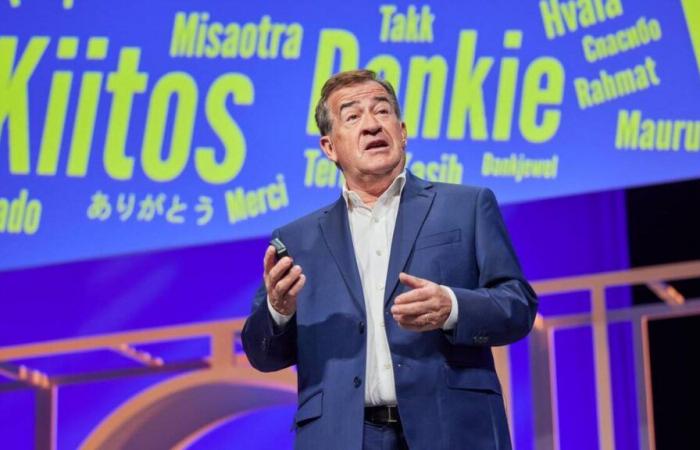Throughout this period, Temenos has been faced with a changing market, with the rise of the cloud and SaaS, that is to say software operated by service providers – like Temenos – and accessible remotely by their customers. These developments continue to have considerable repercussions on Temenos’ business model, explains Jean-Pierre Brulard. With positive aspects – more recurring and more predictable revenues, which the financial markets love – but also challenges to overcome: maintaining margins and growth during this transition period.
The management of this development was therefore entrusted to a Breton native who worked in Silicon Valley, where he headed global sales for the software giant VMware, specializing in particular in the cloud and with more than 30,000 employees. One of the rare Europeans to have climbed so high in the hierarchy of a Californian technology group, Jean-Pierre Brulard looks back on the directions revealed by Temenos during its investor day on November 12 and deciphers the major developments in the fintech sector . Between the need to reduce costs for banks and the emergence of new technologies like generative artificial intelligence and crypto, all in a highly regulated sector.
Le Temps: There is a lot of talk about generative artificial intelligence at the moment. Concretely, what influence does this technology have on your activity, your software?
Jean-Pierre Brulard: Along with the cloud, generative artificial intelligence is the other major area in which we will invest massively over the next four years. Major partners like Microsoft and Amazon Web Services are investing billions of dollars in the platform part and our goal is to embed generative intelligence in our software, for specific use cases.
For example?
There are some fairly easy things, like integrating Copilot, Microsoft’s chatbot that allows you to create text and other content, into our products. A determining element will be to link data management and generative intelligence. We must absolutely avoid mixing bank transactional data, which is ultra-secure, and analytical data. Internally, we already use generative artificial intelligence for software development and for user support, which becomes predictive. We use data from the thousand banks we serve around the world to anticipate future problems, in the use of our products or in terms of cybersecurity.
What will generative AI enable users of your software?
In wealth management, for example, advisors will be able to improve their service by relying on data such as user profiles or returns obtained by other clients. AI will not replace humans, but improve practices. This technology must be well supervised; the best way to do this is to integrate it into our software, with the approval of regulators and compliance specialists in banks.
Does your software allow you to manage cryptos or integrate them into a bank’s activity?
Not yet, we are thinking about the added value we could bring to this market. This is the same thinking as when digital technology and neobanks emerged. We had completely integrated digitalization into our offerings, which allowed us to serve both existing banks that wanted to digitalize, but also fintechs and neobanks that needed a technological platform to develop.
Why did you decide to invest heavily in the cloud?
Customers themselves have already invested heavily. The largest banks have invested heavily in the cloud, whether public or private, for reasons of agility, stability, cost of performance and even security. We must follow this moment. In addition, the cloud allows us to perform maintenance and improvement of our products almost continuously. It’s more painless for our customers than performing an annual update, and it will provide us with much more recurring and predictable revenue, which should support Temenos’ valuation.
What about small banks?
As they generally do not have the resources to invest in the cloud and cloud management, we provide them with a turnkey service, that is, we manage the cloud operations for them.
To give you some figures, our market is expected to grow from $23 billion to $30 billion in 2028, which represents annual growth of 7%. We want to grow faster. However, the so-called “on-premise” activity (in which the bank runs its software on its own servers) should increase from 67% to 59% of this total in 2028, with growth of 4% per year. Conversely, the cloud part (the bank runs its software on a cloud infrastructure) and SaaS (Temenos runs the software for the bank on a cloud infrastructure) will progress, going from 33% to 41% of the market, with double-digit annual growth. The SaaS segment will grow by 12% annually and the cloud, by 16%.
What will this change for Temenos?
These trends result in a change of model. In the “on-premise” model, licenses are sold initially, which creates immediate income. When you move to a SaaS model, you defer revenue while you still have your expenses. As Temenos is listed on the Swiss stock exchange, our shareholders also ask us to maintain operating margin during this transformation. The dilemma that we must resolve is the following: we must move to this recurring revenue model, and at the same time guarantee an operating margin and good cash flow.
It seems like we have to sacrifice something…
This balance is not easy to maintain. In the United States, software companies that went through this process, such as Adobe, did not hesitate to have almost negative figures during the transformation. We must ensure both aspects. Over the last five years, Temenos’ recurring revenues have increased from 60 to 80% of total turnover. At the same time, the company maintained its operating margin and its investments in research and development, but at the expense of growth, which was weaker than investors expected. This explains the evolution of the last five years [l’action Temenos a perdu plus de 60%, ndlr]. We still have investments to make to move towards more recurring revenue. We also announced on November 12 at Capital Market Day that we were going to invest nearly $150 million over the next four years in products, technology and sales, particularly in the United States.
Why do you focus on the United States?
On the one hand, because it is the largest market, which represents 35% of our potential sales, and on the other hand, because the approximately 150 American regional banks must invest in technology to face competition big ones and not to be bought out. Several large regional banks that I met recently have already invested.
During the recent investor day, why did you postpone the medium-term objectives by a year?
After some disappointment among investors with growth over the last four or five years, regaining confidence requires credible, realistic objectives and investments, which are engines of growth. We have also defined crossing points in achieving our objectives. Moreover, the stock reacted well after the presentation of this strategy; it was a $400 million day [l’augmentation de la capitalisation boursière ce jour-là, ndlr]so that was pretty cool.
Nevertheless, the stock remains more or less where it fell after the Hindenburg Research report, which accused Temenos of various wrongdoings.
Restoring confidence will also require a certain number of quarterly results; this will not be done over a single quarter. The market will demand consistent performance quarter after quarter. What Temenos is experiencing is not a turnaround [un redressement, ndlr]it is an acceleration.
Do you think investors still have doubts about Hindenburg Research’s claims?
The accusations have been convincingly refuted. The perception of the company has been completely clarified. The board of directors invested a huge amount of money and energy, entrusting an independent investigation to companies in the United States and Europe, which actually weighed a little on our accounts this year. We analyzed hundreds of thousands of documents, going back three years, to review all the allegations.
How much did this investigation cost?
I can’t tell you. I would have preferred that we invest this money for our clients rather than for short sellers who have been going back and forth on the markets. I must also say that we have had a lot of trust and support from our customers during this period.
When you were approached to take over the management of Temenos, what was your first reaction?
I was interested in the opportunity to run a publicly traded company, which I had never done. I have worked in large American groups and spent more than seven years at Business Objects, which is a European software company. So I know the challenges that a European company can encounter to succeed in a global market. What also interested me was being able to have an impact on the new chapter of Temenos. I will never forget what a client I met shortly after I took office said to me: “If we have to change banking software, it’s like heart surgery. If we can avoid it, we avoid it.” Our customers trust us and want to see us succeed.
Bio express
1959 Born in Rennes (Brittany).
1983 Start of career at Unisys.
2000 Business Objects, becomes responsible for the EMEA zone.
2009 Joined VMware, became vice president in 2020.
May 2024 CEO of Temenos.






